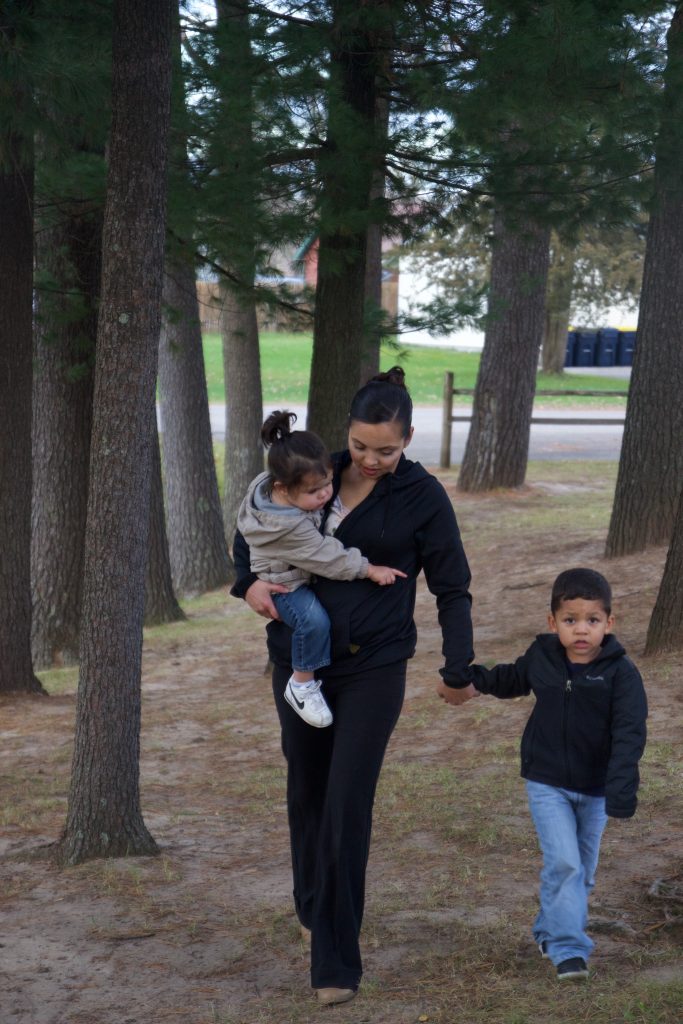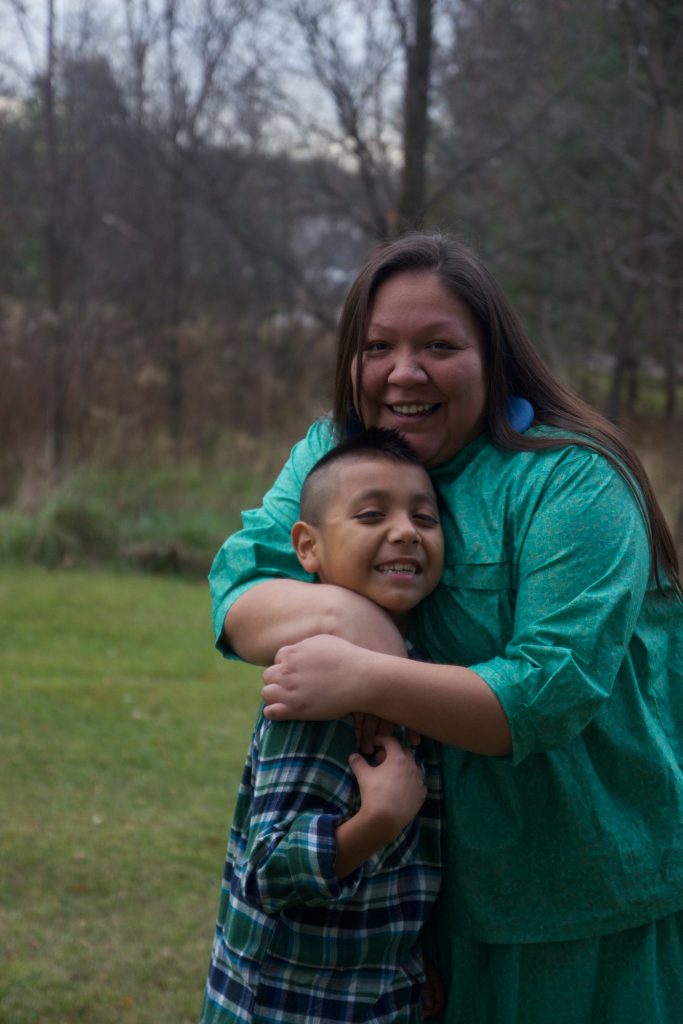Hikoroke. Estelle Greendeer first heard the Ho-Chunk language spoken by her hikoroke, her grandmother. Whether she was crouched in the kitchen cooking or leading the prayer before dinner, her grandmother taught her the Ho-Chunk language through action, eventually hoping Estelle would catch on.
She admits the phrases she was most familiar with growing up were commands, but it didn’t make hearing the foreign words any less special.
And now, after taking evening classes in Wisconsin Dells, Greendeer, 33, is able to speak in broken Ho-Chunk phrases over the phone to her hikoroke.
Although she laughed about the fact she had to repeat the sentence a couple times so her grandmother could understand, it was something new for her, and to be able to share it made her realize the reason she was making this commitment.
“The language is so beautiful when it’s spoken fluently … everything flows together,” she says.
These classes are a part of the Ho-Chunk Academy’s efforts to integrate language into their community after seeing a substantial decline in native speakers as elders grow older. The effort is mainly driven by the middle generation, between elders and youths, as parents want their children to grow up having a connection to their heritage, like they did.

The Ho-Chunk nation is not unique in this effort; it’s a part of a greater movement among Native Americans across the country, needed because of historical discrimination in 1879, Richard Henry Pratt founded the first Native American boarding school, the Carlisle Indian Industrial School.
His philosophy was that students would assimilate to English culture through total immersion, changing their lives dramatically. Students were given uniforms and new English names, and they could no longer speak their own language, even to each other.
Within a few generations, most had forgotten their native tongues.
While there are an estimated 155 indigenous languages still spoken in the United States, 135 of these, 87 percent, are classified as dying. At today’s rates of language transition, 105 are expected to be extinct by 2025, and with all 135 expected to be gone by 2050. The 20 remaining may soon be fighting to survive.
Increasingly, young Native Americans grow up only speaking English, and learning, at best, a few words from their ancestors.
Ho-Chunk classes are offered after school as part of the nation’s youth services and are taught in high schools in three locations: Black River Falls, Tomah and Wisconsin Dells. But after that, students are on their own.

This leads to a knowledge gap, which Kayree Funmaker, 24, a student in the day course, credits to many students not seeking out resources and continuing their studies independently.
However, Wisconsin’s sovereign nations are showing that these so-called “dying” languages can be brought back to life.
There’s a budding interest in a different generation: adults and parents. Greendeer wanted to carry on her traditional heritage with Jackson, her 8-year-old son. There are so many stories passed down and ceremonies held where Ho-Chunk is exclusively spoken, she says.
“I want to be able to tell (my cųųužąk or cųųšge), my nieces or nephews what’s going on, like my ancestors did to me,” she says. “But at the same time I need to learn.”
Greendeer says her long-term goal has been to learn as much of the language as she can. The class setting, where she’s held accountable for absent days, and the opportunity to learn outside of class with homework and audio exercises, is a motivation.
But thankfully, she doesn’t feel like she’s going through the experience on her own. Her brother, a fluent Ho-Chunk speaker, was able to simplify complex topics for her at the dinner table.
“It was kind of tricky to me,” Greendeer says. “[The language is] like plugging in different things like a mathematical equation or something like that.”
But this overwhelming feeling soon vanished with practice for committed students. Now, when Greendeer attends ceremonies, she’s able to pick apart words she learned in class, which is reassuring, and comforts her to feel closer to the meaning of the celebrations, although she’s still not able to understand phrases fully.
“When I go to our ceremonies, to hear the men and women speaking together [in Ho-Chunk] gives me a reference to what our culture stands for,” another student Roberta Funmaker says. “Respect, family, care.”
Just hearing the language spoken is priceless and meaningful to remembering past memories of her childhood, Funmaker says. When she learned a phrase in class, she’d recall hearing her father first say it or teach her during a football game or in the park when she was growing up.
“Whenever I hear Ho-Chunks from the generation above me speaking fluently, I always sit and listen,” Funmaker says. “It’s like a warm bowl of oatmeal.”
The course at all three locations lasted nine to 12 weeks and was offered both during the day and at night. The locations: Black River Falls, Tomah and the Wisconsin Dells are the most populated areas for the Ho-Chunk Nation in Wisconsin. When the class resumes again in January, it’ll be replaced with an online version online to reach a larger audience from across the country with a limited amount of teachers. The nation hopes to bring back the in-person class at a later time.
The online class allows teachers to reach more students, including members of the Ho-Chunk Nation from across the country who are interested in learning a part of themselves. It also helps teachers instruct a larger group of students, as resources are extremely tight with a limited number of fluent speakers.
Although not for long, once ready — instructors and staff in a full-immersion course with the goal of fluency at the Hoocak Academy will assist in the teaching efforts. Hoocak is the Ho-Chunk translation of Ho-Chunk.

Angelica Greendeer, one of the teachers of the course and Estelle’s sister-in-law, hopes that with more people taking action and being a part of saving the language, the Ho-Chunk nation won’t need a language division anymore.
“I really feel that with all of us, our generation with our kids and with the support from our elders,” Angelica Greendeer says. “We can make this a surviving language.”
Kayree Funmaker has already started incorporating phrases she’s learned into conversation with her two sons. Whatever she learned from class, she’d bring back home. She’s been practicing and speaking with both her sons, so they’d be familiar hearing the language, just as she was growing up.
“As I was learning, he was picking up some of the words with me,” Estelle Greendeer says of her son, Jackson.
It wasn’t always easy. Jackson, a third-grader, had a lukewarm relationship with learning in classes, so he wasn’t as easygoing as some younger learners, Estelle says. But she did notice that he would ask questions and they’d help each other out, both curious about the pronunciation and vocabulary of the language. She even brought him to afternoon class a couple of times.
Although there were not a lot of children enrolled in the evening class, Angelica Greendeer says, some families wanted their children to know that they were learning, so they’d bring them along.
It wasn’t just a distinct experience for adults who haven’t been in a classroom for years — it was challenging for instructors as well.
“It’s different when I’m put in a situation when I have people that are older than me, veterans, in the classroom,” Angelica Greendeer says. “The best part is to just be respectful, try to understand where they’re coming from.”
Hearing students share different stories about their families and their past, and getting everyone in the community connected has made the effort to teach Ho-Chunk worth it.
“We’re all bonding in the class and all learning,” Roberta Funmaker says. “I just hope that more people take to it instead of looking at it like it’s school … when I go to class, it’s like music to my ears,” she says with a big smile and a laugh. “I don’t care if I can follow along now, I just listen anyway.”
It’s been a compelling transition, as Roberta Funmaker remembers when she was young. Her parents would turn to her and her siblings to help them with English, asking her to read newspaper headlines and explain television shows.
Now it’s more about taking responsibility for you and your children, Angelica Greendeer says.
“When the kids understand it, I think it makes other [parents] really want that experience for themselves and their kid,” she says.

With Ho-Chunk parents and grandparents being brought together for class with all different backgrounds and upbringings, it made for an interesting, cross-generational learning experience outside of the syllabus.
In one class spent discussing family, if students knew their parents and grandparents’ Ho-Chunk names, they were able to introduce them by that, Kayree Funmaker explains. “The knowledge that these people have about their families … to me, it’s awesome to hear.”
At the end of the course, instructors pushed responsibility back to students, saying if preserving the language is something they want and believe in, they need to speak up and set a good example for their children.
For Estelle Greendeer, this initiative means picking up the phone and calling her grandmother or driving to the House of Wellness, a community center in Wisconsin Dells where the class takes place, and talking with the speakers, those fluent and others learning.
“I know how important the language is,” she says, taking a deep breath. “I don’t want the little prayer that we do to be the only Ho-Chunk my son knows.”
Gabrielle DiBenedetto

Usually the loudest in the room, Gabrielle loves to talk and meet new people, leading her to attend school in the midwest from Boston (accent-less). Beyond words, numbers tell just as powerful a story. As a double major in economics and journalism, Gabrielle is an unapologetic data geek and sometimes a bit over-caffinated. Above all, she’s fascinated with how to present complex information clearly. After graduation, she’ll step out of the newsroom and take on a new challenge at a data research-haven in Chicago.
